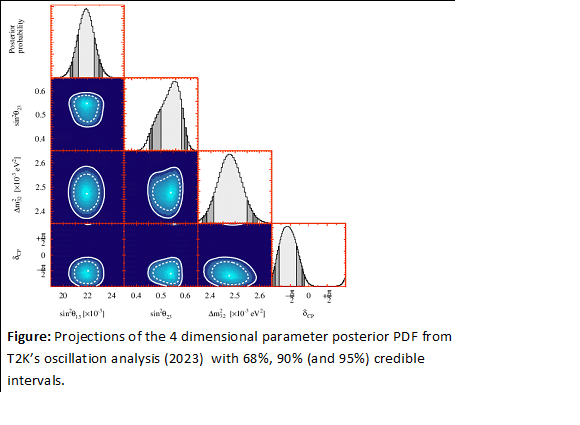Neutrino Oscillations
The main focus of the group is the analysis of neutrino oscillations, particularly the search for Charge-Parity (CP) violation. This phenomenon causes a subtle difference between the behaviour of matter particles and their antimatter equivalents and is a leading candidate to explain the apparent absence of antimatter in the observable universe. CP-violation has been known to exist in the quark sector for a long time but the observable effects in the lepton sector are quite different and it may be a much more significant effect.
Measurements of neutrino mixing through oscillations also help constrain theories about the origin of neutrino mass which is at present entirely unknown. The extreme scale difference compared to fermions such as the electron and the large mixing between mass and electroweak ‘flavour’ eigenstates suggest neutrinos may be unique among fundamental particles in gaining mass from something other than the Higgs mechanism.
Neutrinos at Glasgow
Neutrinos at Glasgow
The group has extensive experience in neutrino and muon physics dating back to neutrino factory R&D in 1999, and for many years took a leading role in the Muon Ionisation Cooling Experiment (MICE), which demonstrated ‘cooling’ of secondary muon beams—a prerequisite for a future neutrino factory. Glasgow PPE has been working on the T2K experiment since 2018, although individual members have been involved since 2008. Alongside several other UK universities, we joined the Hyper-Kamiokande (Hyper-K) collaboration at its formation.
On T2K our primary activity is in neutrino oscillation analyses, particularly the development of new techniques and integration with external data sets, such as the modern reactor experiments and joint analysis with other oscillation experiments. We also lead the effort to update the primary target simulation, which is used to calculate the initial neutrino flux and the correlations between near and far detectors that are key to the long-baseline technique.

More information about the T2K experiment
On Hyper-K, we are developing specialised electronics for the ‘Outer Detector’, which tags both cosmic rays entering the larger ‘Inner Detector’, and muons from neutrino interactions that escape, so they can be analysed as a separate class of events. We are also active in PMT and full system (PMT + electronics) testing. Building on our T2K activities, we are looking to reoptimize the beam design for the physics goals of Hyper-K, and develop a version of the T2K oscillation fitters that will be ready for Hyper-K from Day 1 of data-taking.
More information about the Hyper-K experiment

